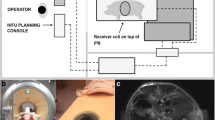Abstract
Purpose
This study was designed to compare technical parameters during ablation as well as CT 3D rendering and histopathology of the ablation zone between sphere-enhanced microwave ablation (sMWA) and bland microwave ablation (bMWA).
Methods
In six sheep-livers, 18 microwave ablations were performed with identical system presets (power output: 80 W, ablation time: 120 s). In three sheep, transarterial embolisation (TAE) was performed immediately before microwave ablation using spheres (diameter: 40 ± 10 μm) (sMWA). In the other three sheep, microwave ablation was performed without spheres embolisation (bMWA). Contrast-enhanced CT, sacrifice, and liver harvest followed immediately after microwave ablation. Study goals included technical parameters during ablation (resulting power output, ablation time), geometry of the ablation zone applying specific CT 3D rendering with a software prototype (short axis of the ablation zone, volume of the largest aligned ablation sphere within the ablation zone), and histopathology (hematoxylin-eosin, Masson Goldner and TUNEL).
Results
Resulting power output/ablation times were 78.7 ± 1.0 W/120 ± 0.0 s for bMWA and 78.4 ± 1.0 W/120 ± 0.0 s for sMWA (n.s., respectively). Short axis/volume were 23.7 ± 3.7 mm/7.0 ± 2.4 cm3 for bMWA and 29.1 ± 3.4 mm/11.5 ± 3.9 cm3 for sMWA (P < 0.01, respectively). Histopathology confirmed the signs of coagulation necrosis as well as early and irreversible cell death for bMWA and sMWA. For sMWA, spheres were detected within, at the rim, and outside of the ablation zone without conspicuous features.
Conclusions
Specific CT 3D rendering identifies a larger ablation zone for sMWA compared with bMWA. The histopathological signs and the detectable amount of cell death are comparable for both groups. When comparing sMWA with bMWA, TAE has no effect on the technical parameters during ablation.






Similar content being viewed by others
References
Gillams A (2009) Tumour ablation: current role in the kidney, lung and bone. Cancer Imaging 9 Spec No A:S68-70
Pompili M, Saviano A, de Matthaeis N et al (2013) Long-term effectiveness of resection and radiofrequency ablation for single hepatocellular carcinoma ≤3 cm. Results of a multicenter Italian survey. J Hepatol 59(1):89–97
Rutherford EE, Cast JE, Breen DJ (2008) Immediate and long-term CT appearances following radiofrequency ablation of renal tumours. Clin Radiol 63(2):220–230
Brace CL (2009) Microwave ablation technology: what every user should know. Curr Probl Diagn Radiol 38(2):61–67
Simon CJ, Dupuy DE, Mayo-Smith WW (2005) Microwave ablation: principles and applications. Radiographics 25(Suppl 1):S69–S83
Sommer CM, Lemm G, Hohenstein E et al (2013) CT-guided bipolar and multipolar radiofrequency ablation (RF ablation) of renal cell carcinoma: specific technical aspects and clinical results. Cardiovasc Intervent Radiol 36(3):731–737
Andreano A, Huang Y, Meloni MF, Lee FT Jr, Brace C (2010) Microwaves create larger ablations than radiofrequency when controlled for power in ex vivo tissue. Med Phys 37(6):2967–2973
Ni JY, Liu SS, Xu LF, Sun HL, Chen YT (2013) Meta-analysis of radiofrequency ablation in combination with transarterial chemoembolization for hepatocellular carcinoma. World J Gastroenterol 19(24):3872–3882
Xu LF, Sun HL, Chen YT et al (2013) Large primary hepatocellular carcinoma: transarterial chemoembolization monotherapy versus combined transarterial chemoembolization-percutaneous microwave coagulation therapy. J Gastroenterol Hepatol 28(3):456–463
Vollherbst D, Fritz S, Zelzer S et al (2014) Specific CT 3D rendering of the treatment zone after irreversible electroporation (IRE) in a pig liver model: the “Chebyshev Center Concept” to define the maximum treatable tumor size. BMC Med Imaging 14:2
Sommer CM, Koch V, Pap B et al (2011) Effect of tissue perfusion on microwave ablation: experimental in vivo study in porcine kidneys. J Vasc Interv Radiol 22(12):1751–1757
Sommer CM, Kortes N, Zelzer S et al (2011) Renal artery embolization combined with radiofrequency ablation in a porcine kidney model: effect of small and narrowly calibrated microparticles as embolization material on coagulation diameter, volume, and shape. Cardiovasc Intervent Radiol 34(1):156–165
Hoffmann R, Rempp H, Clasen S (2012) Microwave tumor ablation. new devices, new applications? Radiologe 52(1):22–28
Sommer CM, Arnegger F, Koch V et al (2012) Microwave ablation of porcine kidneys in vivo: effect of two different ablation modes (“temperature control” and “power control”) on procedural outcome. Cardiovasc Intervent Radiol 35(3):653–660
Zhang YJ, Liang HH, Chen MS et al (2007) Hepatocellular carcinoma treated with radiofrequency ablation with or without ethanol injection: a prospective randomized trial. Radiology 244(2):599–607
Wang X, Sofocleous CT, Erinjeri JP et al (2013) Margin size is an independent predictor of local tumor progression after ablation of colon cancer liver metastases. Cardiovasc Intervent Radiol 36(1):166–175
Sommer CM, Sommer SA, Sommer WO et al (2013) Optimisation of the coagulation zone for thermal ablation procedures: a theoretical approach with considerations for practical use. Int J Hyperthermia 29(7):620–628
Stampfl S, Bellemann N, Stampfl U et al (2009) Arterial distribution characteristics of Embozene particles and comparison with other spherical embolic agents in the porcine acute embolization model. J Vasc Interv Radiol 20(12):1597–1607
Iwamoto T, Kawai N, Sato M et al (2008) Effectiveness of hepatic arterial embolization on radiofrequency ablation volume in a swine model: relationship to portal venous flow and liver parenchymal pressure. J Vasc Interv Radiol 19(11):1646–1651
Disclosures
Technically AngioDynamics, Queensbury, NY, as well as CeloNova BioSciences, San Antonio, TX, supported this study.
Conflict of Interest
Theresa L. Gockner, Sascha Zelzer, Theresa Mokry, Daniel Gnutzmann, Nadine Bellemann, Carolin Mogler, Anja Beierfuß, Eva Köllensperger, Günter Germann, Boris A Radeleff, Ulrike Stampfl, Hans U. Kauczor, Philippe L. Pereira, Christof M. Sommer declare that this study was technically supported by AngioDynamics, Queensbury, NY as well as CeloNova BioSciences, San Antonio, TX.
Human and Animal Rights
All applicable institutional and/or national guidelines for the care and use of animals were followed.
Author information
Authors and Affiliations
Corresponding author
Rights and permissions
About this article
Cite this article
Gockner, T.L., Zelzer, S., Mokry, T. et al. Sphere-Enhanced Microwave Ablation (sMWA) Versus Bland Microwave Ablation (bMWA): Technical Parameters, Specific CT 3D Rendering and Histopathology. Cardiovasc Intervent Radiol 38, 442–452 (2015). https://doi.org/10.1007/s00270-014-0964-4
Received:
Accepted:
Published:
Issue Date:
DOI: https://doi.org/10.1007/s00270-014-0964-4




